- Home
- Palm Problems
- Palm Fronds Turning Yellow
Palm Fronds Turning Yellow - What’s Going On?
What's with your palm fronds turning yellow?
Noticing your palm fronds turning yellow can be a little alarming! Especially when you’ve been taking good care of your palm tree. In the botanical world, yellow leaves are called chlorosis.
The good news? Yellow leaves don’t always mean disaster. It may be your palm’s way of saying, “Something’s not right - please give me a check-up!”
We have some tips for figuring out this Palm Tree Problem of leaf yellowing. And figuring out what to do about it.
Feeling overwhelmed by so many palm trees?
You're not alone. We Understand your headaches! At Mission: Palm Trees you'll find clear answers to questions & Step-By-Step Guidance, from real people. With solutions to help. No puzzling shoptalk. No tiring research. So it's easy & fun for you.
5 Things to Check When Palm Leaves Turn Yellow
Let’s walk through the most common reasons palms start yellowing.
We'll show you what to do about it. And you'll know how to prevent that in the first place.
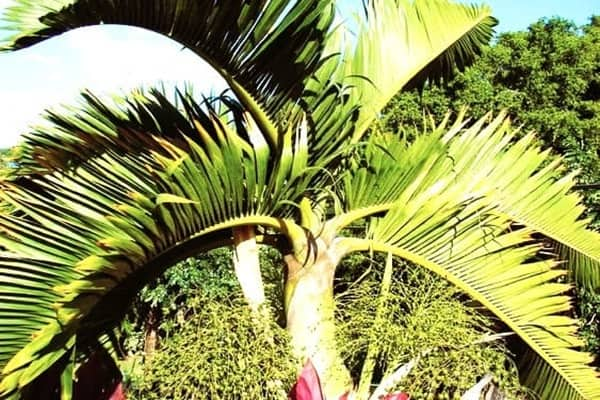 Seeing yellowing fronds like these get your attention!
Seeing yellowing fronds like these get your attention!Tip 1 for Palm Fronds Yellowing – Weather Stress
Palms may look tough, but they’re very picky about climate.
Planting a palm tree outside its natural growing zones could invite problems with palm fronds turning yellow.
COLD SNAPS
- Is your palm plant a Palm That's Cold Resistant? It will likely be alright.
- Climates without extremely cold winters are sometimes are affected by a sudden hard freeze. Innumerable Species Can be Affected, and the fronds can begin to yellow.
- Tropical palms like Coconut Palms hate the cold. A single hard freeze often turns fronds yellow and limp.
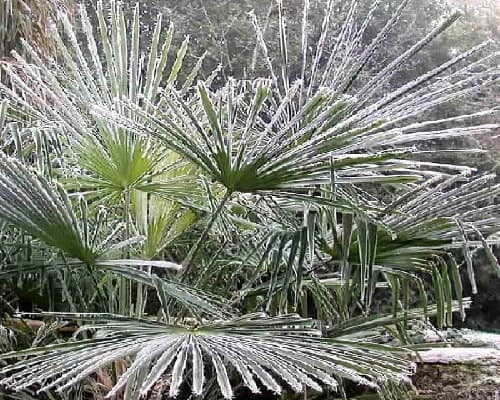 When the frost melts, leaf yellowing may start.
When the frost melts, leaf yellowing may start.HEAT WAVES
On the other hand, hot weather spells can cause chlorosis in some palms.
- Species who have high-mountain origins, where it's generally cooler, will suffer with unexpected high temperatures.
- For instance, Ceroxylon quindiuense, the Tallest Palm in the World, is like that.
- But other species can't stand the heat. Like the Queen Palms in this video:
What to Do for Palms Enduring Weather Problems
Prevention is the key.
You want to be proactive in preventing this on palms you love.
- By choosing a palm that’s right for Your Climate Zone. The botanical principle is planting the right palm in the right place.
- If you already have a palm, protect it from weather extremes with frost or sun covers, mulch, or a little extra water during heat wave stress.
Tip 2 – Watering Habits Can Cause Yellowing Fronds
 Could be heading to Root Rot & Yellowing Fronds!
Could be heading to Root Rot & Yellowing Fronds!Palms are a bit like Goldilocks when it comes to water: too much or too little, and they’re not happy. Palms want their Watering to be Just Right!
- A few palm tree species like their roots sitting in watery, mucky soil. But most do not.
- Nearly all species are Sensitive to Overwatering. And drought-resistant palms, especially, won't favor excessive watering. Roots sitting in soggy soil can suffocate and rot. The palm fronds begin turning solidly yellow.
- Many palms tolerate temporary drought when mature, but younger palm leaves often yellow if watering is neglected.
For instance, Phoenix canariensis, the Canary Island Date Palm loves well-draining soil. Don’t drown it.
What to do for Palm Watering Problems
Every species is different.
Find out your palm’s watering needs. Use a good Palm Tree Guide Book, and determine the moisture needs of the palm you have.
Generally, palms can tolerate less watering, more-so than too much watering. When in doubt, water deeply but less often. Also be sure the soil drains well.
Tip 3 – Yellow Leaves from Nutrition Gaps
A common reason for palm fronds turning yellow is Nutrient Deficiency.
Like people, palms need a good diet. Without it, leaves fade from green to yellow.
Because palms need certain macronutrients & micronutrients to maintain green leaves. Inadequate nutrition can cause unhealthy palm frond yellowing.
Lack of Needed Macronutrients for Palms
Macronutrients are needed in larger amounts. Which macronutrient deficiencies cause palm fronds yellowing?
- Nitrogen, mainly in Container Palms. Green color fades to pale green, then turns yellow.
 Nitrogen deficiency was verified in this Coconut Palm
Nitrogen deficiency was verified in this Coconut Palm- Phosphorus shortage affects oldest, lower fronds first, with gradual yellowing.
- Potassium lack is a top cause of yellowing. Especially in outdoor Royal and Areca palms.
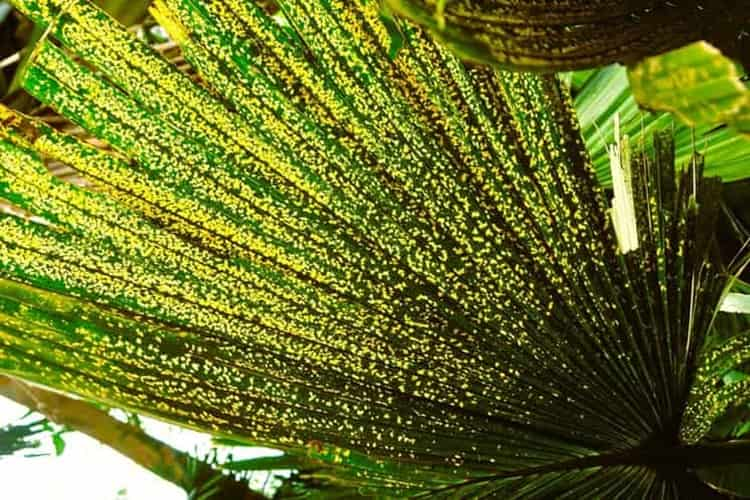 Yellow polka-dots aren't decorative on this palm frond! Prime indication for potassium deficiency.
Yellow polka-dots aren't decorative on this palm frond! Prime indication for potassium deficiency.- Magnesium shortfall mostly happens when Palms are Growing in sandy soil & in containers. Creating distinct wide yellow bands along edges of older fronds.

- Sulfur deficit hits youngest (uppermost) fronds first. Yellowing completely or just between leaf veins.
Lack of Needed Micronutrients for Palms
Micronutrients are needed in trace (very small) amounts. Yet they're important to healthy palm life.
- Iron decline is more common in potted palms than in landscapes. Newer leaves turn yellow first.
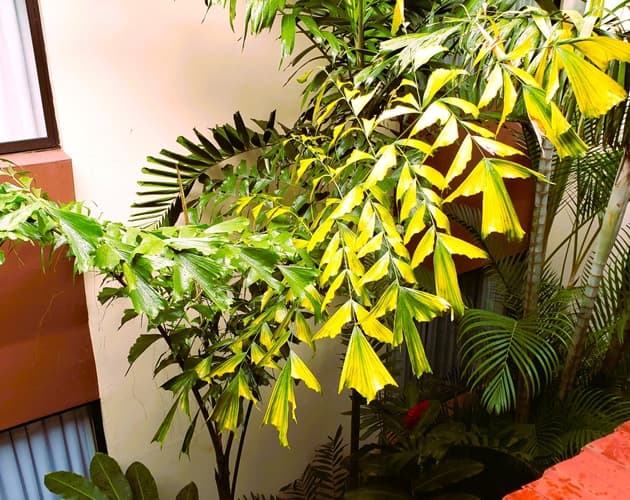 Fishtail palm with verified iron inadequacy. Note the yellowing aside the veins.
Fishtail palm with verified iron inadequacy. Note the yellowing aside the veins.- Copper sparsity is rare. Exception is African Oil Palms growing in sandy soil.
- Manganese shortage is most common with alkaline, sandy soils. New fronds are small & yellow, with long black streaks. They typically curl with a frizzled look.
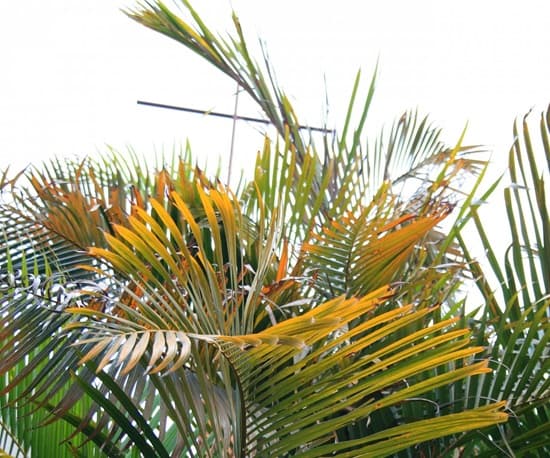 May be lacking manganese or copper. Newer leaves yellowing at tips, with brown stripes. Gradually affecting the whole leaf.
May be lacking manganese or copper. Newer leaves yellowing at tips, with brown stripes. Gradually affecting the whole leaf.What to do for Palm Nutrition Problems
Know what's best for your Palm's Nutritional Needs.
- Consider if it's planted outdoors, or potted in a container?
- Feed with a good slow-release Palm-Specific Fertilizer.
- Outdoor palms need more frequent feeding than indoor container palms.
Most (if not too far gone) can bounce back when they get the food they need.
Tip 4 – Yellow Fronds From Disease Trouble
Palms under stress are like open invitations to fungi and diseases.
Fungus is often opportunistic, attacking when palms are weak from problems. Fungal Problems can be difficult to diagnose. Professional analysis is best, getting a sample to culture.
- Leaf Spot or Blight: Leaf chlorosis, or yellow spots with brown/black rings or centers. Young palms more easily attacked.
 Dark spots become ringed with yellow borders.
Dark spots become ringed with yellow borders.- Tar Spot: Black narrow, angular or diamond-shaped patches along veins. As the whole frond is turning yellow.
 Very distinctive symptoms of Tar Spot
Very distinctive symptoms of Tar Spot- False Smut: Tiny yellow dots on upper & low leaf surfaces. Not deadly, but unattractive.
The serious ones (that can kill the palm's heart - growing point):
- Lethal Yellowing: Seen in Coconut Palms and Trachycarpus fortunei. Starts on oldest fronds and works upward. Spreads upward, coloring fronds (some very bright) yellow.
- Bud Rot: Newest fronds discolor, eventually the fungus reaches the heart (meristem/growing point).
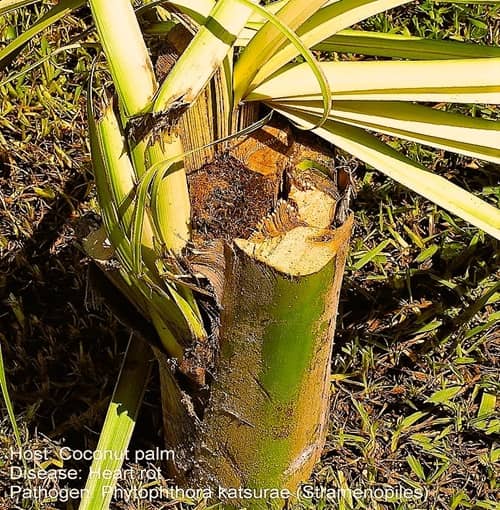 Coconut killed by lethal Bud Rot. Also called Heart Rot.
Coconut killed by lethal Bud Rot. Also called Heart Rot.What to do for Palm Disease Troubles
It's important to catch disease problems early.
- Remove affected fronds may help, but it's still best to discover which palm disease it is.
- If it's a lethal fungus the palm should be removed to avoid spread.
- If it's just beginning, and not the deadly variety, treatment with a palm antifungal might help.
- Keep the tree well-fed and watered (but not overwatered).
- Call in a palm specialist from a local extension service, if you suspect a serious or fungal disease.
Tip 5 – Palm Fronds Turning Yellow From Insects
Sometimes, yellowing fronds mean pesky bugs are stealing your palm’s lunch!
Pests that cause palm fronds turning yellow:
- Aphids: Gather on new fronds, skewering palm leaves to suck out inner tissues.
- Yellowing the leaf surface and stunting palm plant growth.
- Palm aphids look different from other plant aphids.
- Their major problem is leaving behind honeydew, their sugary white, thready poop. From that surface, sooty mold develops.
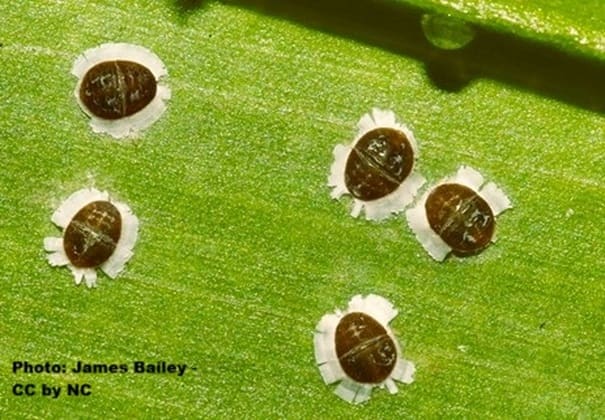 Cerataphis brasiliensis specifically target palms.
Cerataphis brasiliensis specifically target palms.- Palm Leaf Skeletonizer: Caterpillars that eat between leaf surfaces, causing blotchy yellow damage. Read About Its Yucky Methods to harm your palm.
- Palm Weevils: Bore into stems, weakening the tree and often turning fronds yellow. Problem is, symptoms appear late in its attack.
 Views & stages of the red palm weevil.
Views & stages of the red palm weevil.What to do About Annoying Insects on Palms
Inspect your palm regularly & closely.
For smaller problems, try natural remedies like horticultural oil or insecticidal soap. It's best to avoid chemical systemic insecticides if at all possible (remember early prevention by inspection) because if They Contain Pyrethroid, beneficial insects are killed, too.
Lots of friendly bugs like to eat Aphids, you can try releasing some.
Red palm weevils are a serious threat that can lead to death. Spread prevention and treatments are:
- Be aware of infested palms in your area, to use proactive prevention. And remember healthy palms are not the typical targets.
- Good sanitation measures by removing seriously infected palms
- Pheromone trapping also can work.
- People have used traps to capture and destroy them.
- As a last resort spray insecticide.
You may need to consult professional help.
What to Do If Palm Fronds Are Turning Yellow
Does all that sound scary?
When yellow leaves develop on your palm it can feel overwhelming. But the trick is to go step by step.
- Identify your palm species first. To narrow down likely causes because of its vulnerability.
- Check for obvious issues: watering, nutrition, pests, or weather damage.
- Don’t rule out lab soil tests or leaf testing if problems persist.
- Stay proactive! Be on the lookout for palm fronds turning yellow by regular monitoring your palm. That prevents small issues from becoming big ones.
It all comes down to the exact needs & frailties of your palm & its environment. Using proactive watchfulness to get on top of yellowing early.
FAQs About Palm Fronds Turning Yellow
Should I cut off yellow palm fronds?
Should I cut off yellow palm fronds?
Only if they’ve gone completely dead, going from yellow to black/brown. Cutting too early robs the tree of nutrients it’s still using. Any nutrients left in affected fronds are still essential to strength for combatting the problem.
See more about Cutting Off Palm Fronds.
Can yellow fronds turn green again?
Can yellow fronds turn green again?
Not really. Once fronds yellow, they stay that way. Focus on fixing the cause so new growth is healthy. And so avoid more palm fronds turning yellow.
What’s the best fertilizer for helping yellowing palm leaves?
What’s the best fertilizer for helping yellowing palm leaves?
A slow-release Fertilizer Designed for Palms. Look for one with potassium, magnesium, nitrogen, and micronutrients.
[Mission: Palm Trees is made possible by readers like you! If you purchase with the Amazon link below, we earn a small commission. At no added cost to you. Thanks for your support! Learn More>]
We use PALMGAIN Palm Plant Food, getting it at Amazon, and recommend it, as it works well on our young growing palm. It has the proper proportions of palm macronutrients, along with essential micronutrients.
How do I know if it’s disease or just a deficiency?
How do I know if it’s disease or just a deficiency?
Sometimes it's tricky to do, as the symptoms can be similar.
But nutrient problems slowly show more solid yellowing eventually turning brown. While disease often looks patchy, spotted, or banded, and can progress quickly.
Is some palm frond yellowing normal?
Is some palm frond yellowing normal?
Yes! As the palm grows, older fronds naturally yellow, then turn brown and eventually die.
Quick Takeaways for Palm Fronds Turning Yellow
- Yellow fronds can be natural, but more often signal stress.
- Climate, water, nutrition, pests, and disease are the “big five” causes.
- The right palm in the right place and proper watering is half the battle.
- Proactive watchfulness, along with proper care can help palms bounce back strong.
References for this article:
- Elliott, M.L., Plant Pathology Department; UF/IFAS Fort Lauderdale Research and Education Center.
- Broschat, T.K., Meerow, A.W., Elliott, M.L. (2017). Ornamental Palm Horticulture. Gainesville FL, University Press of Florida.




